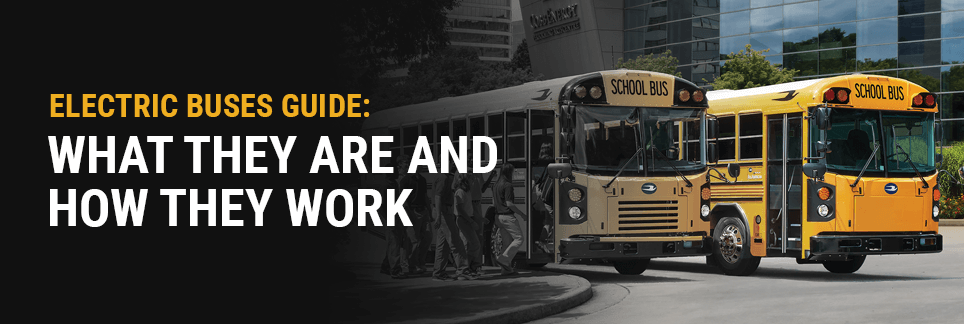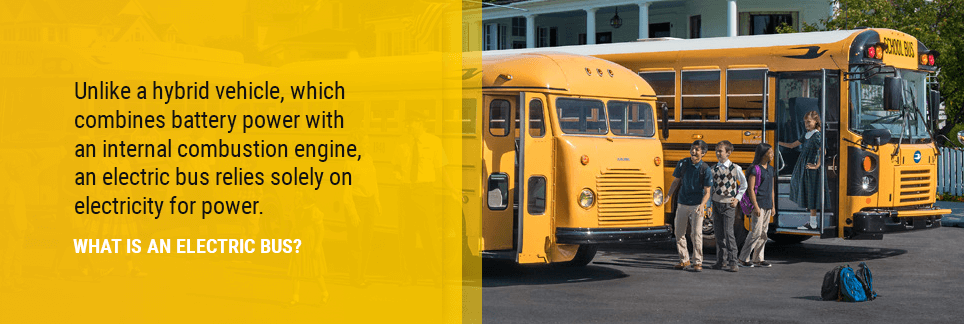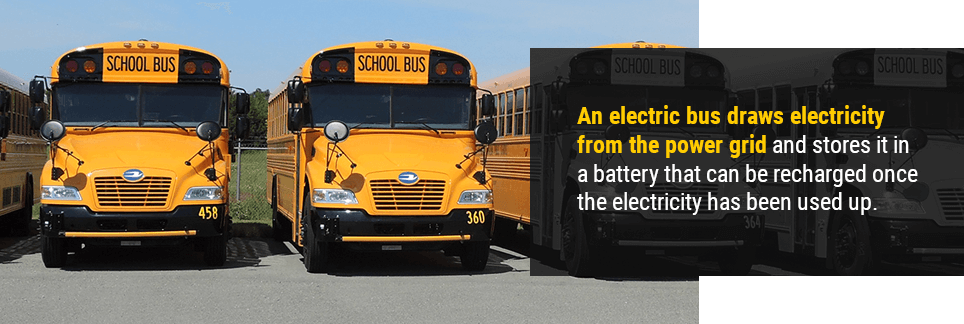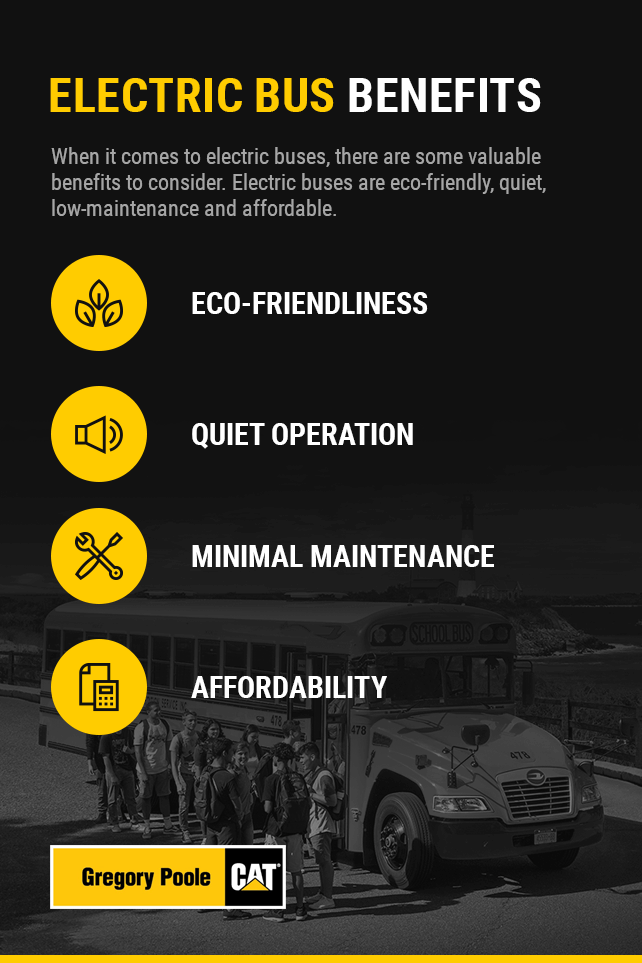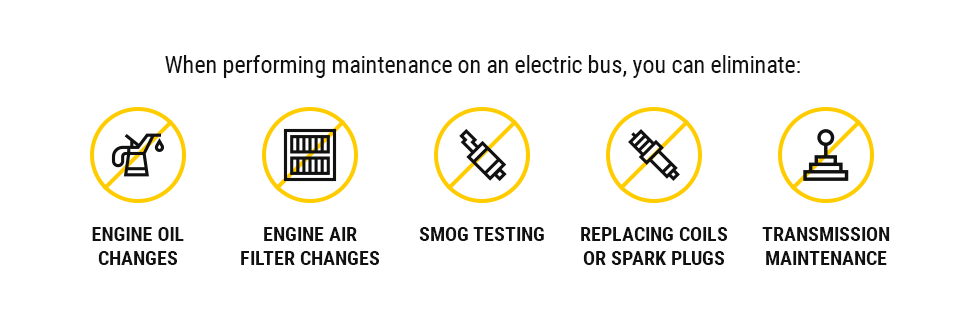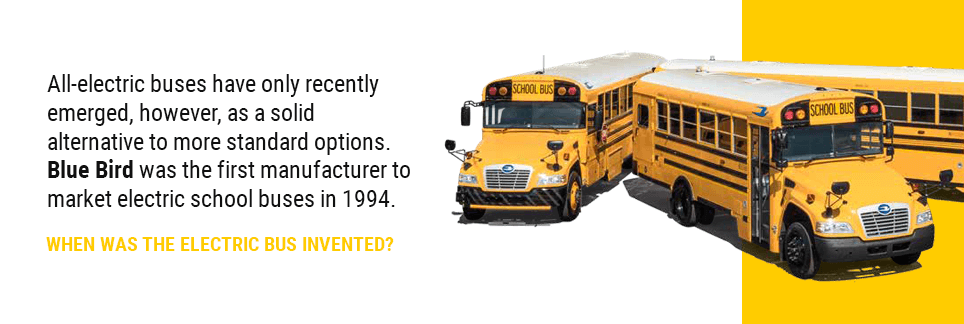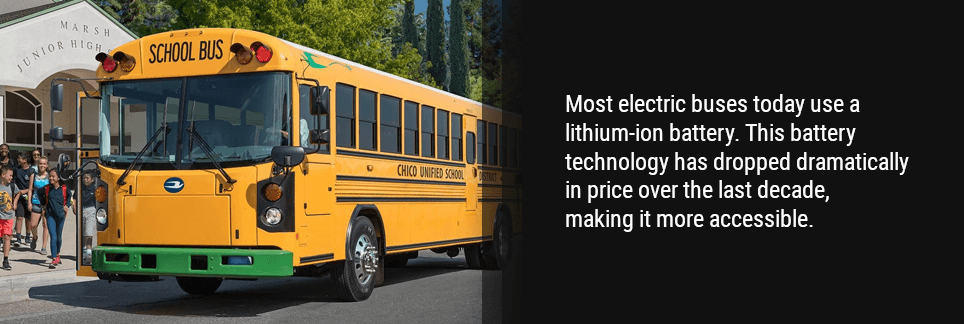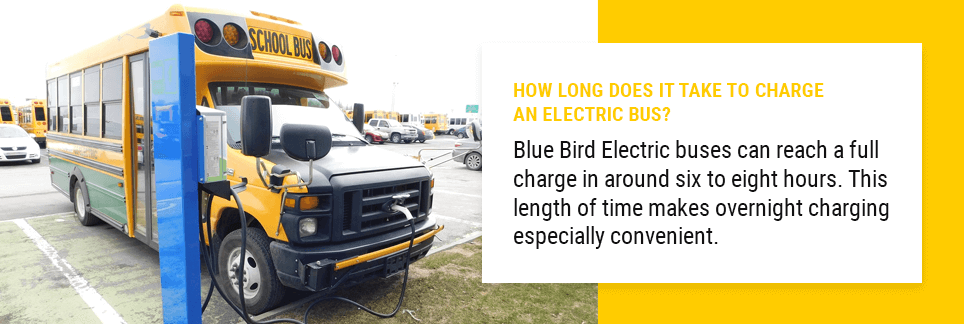Electric Buses Guide: What They Are and How They Work
Electric buses are bursting onto the scene for cities, private transit companies and schools looking for an alternative to traditional buses. These buses are more eco-friendly and can also save you money over time, so it’s no wonder they are gaining popularity. By some estimates, close to half of the world’s city bus fleet could consist of electric buses by 2025. That would be about 1.2 million electric buses, up from 386,000 electric buses in 2018.
Table of Contents
- What Is an Electric Bus?
- How Does an Electric School Bus Work?
- Electric Bus Benefits
- Answers to 10 Common Questions about Electric Buses
- When Was the Electric Bus Invented?
- What Is the Carbon Footprint of an Electric Transit Bus?
- How Much Electricity Does an Electric Bus Use?
- What Kind of Batteries Are Used in Electric Buses?
- How Far Can an Electric Bus Go?
- What Type of Charging Station Does an Electric Bus Use?
- How Long Does It Take to Charge an Electric Bus?
- What Is the Life Expectancy of an Electric Bus?
- Are Electric Buses Healthier?
- Why Aren’t Electric Buses More Common?
- Blue Bird Electric Buses from Gregory Poole
If you’re interested in adding some electric buses to your school’s fleet, keep reading. We’re going to share important information about how electric buses work and answer some common questions about electric buses, so you can make an informed decision.
What Is an Electric Bus?
An electric bus is a type of electric vehicle (EV), meaning it is fueled by electricity rather than other fuel types like diesel fuel or gasoline. Unlike a hybrid vehicle, which combines battery power with an internal combustion engine, an electric bus relies solely on electricity for power. For this reason, electric vehicles are sometimes referred to as “all-electric vehicles” to make it clear that they do not combine electricity with any other type of power.
Electric buses are a newer alternative to more traditional buses, but they are becoming a popular option for cities, private transportation companies and school districts that want to take advantage of EV technology. Electric buses cost more initially than other kinds, but they can save money over time.
How Does an Electric School Bus Work?
An electric bus draws electricity from the power grid and stores it in a battery that can be recharged once the electricity has been used up. This basically mirrors the way our electronics work. We plug them in and let the battery charge and then use them wirelessly until it’s time to charge again.
The main difference between an electric bus and our cell phones and laptops is that the electrically charged battery powers an electric motor in the bus. “The wheels on the bus go round and round,” thanks to this electric motor. More precisely, when the bus driver’s foot presses on the accelerator, the battery powers the motor, which powers the gears that rotate the bus’s tires.
In a traditional bus, a motor works along with an alternator, but an electric motor in an EV has the double function of acting as an alternator and motor. This is possible because the voltage of an AC signal can easily be increased or decreased.
From the driver’s perspective, an electric bus functions essentially like any other type of bus. There is no special way of operating it. Of course, when it’s time to refuel, this is when the difference becomes obvious, but it’s a process that EV drivers quickly become used to.
Electric Bus Benefits
If you’re considering an electric bus for your school, you’ll want to know about the benefits of electric buses. Why should you consider an electric bus over more traditional options? There are advantages and disadvantages to consider with any type of bus — diesel, propane, gasoline, electric or otherwise — so it’s always smart to compare these options and see which is the best fit for your needs. When it comes to electric buses, there are some valuable benefits to consider. Electric buses are eco-friendly, quiet, low-maintenance and affordable.
1. Eco-Friendliness
One of the main reasons to consider an electric bus over other options is how eco-friendly they are. Compared to combustion engines that run on fuel like diesel, an electric vehicle will have a minimal impact on the environment.
Environmental friendliness is also a benefit of hybrid electric buses, but hybrid buses still burn fuel and, therefore, don’t have zero emissions like an all-electric bus does. When your priority is choosing a bus that will contribute to a healthier environment, an electric bus is the clear choice.
2. Quiet Operation
One thing you might notice the first time you drive or ride on an electric bus is how quiet it is. Electric buses operate far more quietly than other types of buses with internal combustion engines. This is always a nice feature of electric vehicles, but it can be a major benefit when it comes to school buses.
School bus drivers in an electric bus are better able to hear what is going on in the seats behind them. This can help drivers feel more of a sense of control and can increase the level of accountability among students on board. A quieter operation can also help drivers maintain better focus on the road.
3. Minimal Maintenance
Another major advantage of electric buses is how little maintenance they require. Many of the maintenance tasks needed with a diesel or gas-powered bus are unnecessary with an electric bus. When performing maintenance on an electric bus, you can eliminate:
- Engine oil changes
- Engine air filter changes
- Smog testing
- Replacing coils or spark plugs
- Transmission maintenance
Additionally, you won’t have to change the coolant as often, and you can get a longer lifespan out of the brake pads. Overall, electric vehicles are extremely low-maintenance compared to other vehicles. Fewer maintenance needs can translate directly into cost savings. It also means buses in your fleet can stay on the road and don’t have to be out of commission at the auto shop as often.
4. Affordability
Some schools may shy away from purchasing electric buses because they cost more than other bus models. These buses do require a larger upfront investment, but they can also save you money over time. Electric buses save money by minimizing maintenance costs and eliminating fuel costs.
These cost savings can add up to around $39,000 per year, which is more than enough to cover the additional cost of an electric vehicle over the bus’s lifetime. You can also offset the cost with government subsidies, tax breaks and grants from your power supply company. Now is a great time to purchase electric vehicles because you can benefit from these financial incentives.
Answers to 10 Common Questions About Electric Buses
Since electric buses are still a relatively new product, many people are skeptical about the idea of adding electric buses to their fleet. Fortunately, we’re here to answer those questions, so you can feel assured that electric buses are a practical option for your school.
1. When Was the Electric Bus Invented?
Electric vehicles have been around for much longer than most people realize. Inventors were working on developing electric vehicles in the mid-19th century. By the late 19th century, electric cars had become practical. William Morrison created the first successful EV in the U.S. and generated some interest in electric vehicles. In the early 20th century, electric cars made up about a third of all vehicles on the road in the U.S.
Gas-powered vehicles continue to dominate the market, but electric vehicles have experienced a resurgence in popularity in recent years. Although the technology for electric vehicles has been around for a while, all-electric buses are a more recent innovation. It’s difficult to pinpoint when the first electric bus was made, though we do know some early bus manufacturers built gasoline-electric models. All-electric buses have only recently emerged, however, as a solid alternative to more standard options. Blue Bird was the first manufacturer to market electric school buses in 1994.
2. What Is the Carbon Footprint of an Electric Transit Bus?
To look at something’s carbon footprint, you should consider its whole life cycle. What sort of impact does it have on the environment throughout its manufacturing, operation, maintenance and disposal? Fortunately, electric buses have an impressively small carbon footprint compared to other buses, making them a great option for schools or cities trying to make a concentrated effort to go green.
All-electric buses also have lower emissions over the course of their life cycle compared to natural gas and diesel-hybrid buses. Blue Bird’s electric school buses produce zero emissions. Of course, the electricity grid itself contributes some emissions. According to the Union of Concerned Scientists, an electric bus that is charged by the national electricity mix will produce 1,078 grams CO2e per mile. Compare that to 2,364 grams CO2e per mile for natural gas and 2,212 grams CO2e per mile for a diesel hybrid.
Whereas usage is the lifecycle stage that accounts for around 90% of a diesel bus’s climate impact, for an all-electric bus, usage could only account for 30%, and that’s out of a much lower total climate impact. Still, this means if you want your electric bus to have as small a carbon footprint as possible, it’s important to focus on the manufacturing part of its lifecycle and purchase from a manufacturer that uses environmentally responsible methods.
3. How Much Electricity Does an Electric Bus Use?
How much energy it takes to run an electric bus depends on a few factors. Just as other types of buses have varying levels of fuel economy, you’ll find varying levels of electricity consumption for electric buses. It also depends on factors like the topography on your route and whether you’re running air conditioning or heat.
In one test, 18-meter electric buses used between 1.65 and 1.84 kilowatt-hours per kilometer traveled. In this scenario, buses were running air conditioning, which accounted for part of the energy consumption.
4. What Kind of Batteries Are Used in Electric Buses?
Most electric buses today use a lithium-ion battery. This battery technology has dropped dramatically in price over the last decade, making it more accessible. This is the same type of battery used in laptops and cellphones. Lithium-ion batteries offer some important advantages that have made it the battery of choice, such as how lightweight it is, how much energy it can hold and how it can be recharged.
When a lithium-ion battery is charging, lithium ions move from the cathode to the anode. When you’re drawing power from the battery, the opposite occurs: the anode releases lithium ions to the cathode. Although modern lithium-ion batteries can hold an impressive amount of energy for their size, they still need to be recharged periodically so you can keep your bus on the road.
5. How Far Can an Electric Bus Go?
For schools considering electric buses, one of the most important questions is, how many miles can an electric school bus go? Will it be able to complete its route without needing a charge? The number of miles an electric bus can travel depends on the bus and particularly on its battery’s power density. It also depends on how much idling is included in your trip and what type of terrain you’re covering, among other factors.
That said, it is possible to estimate how far a bus can go on a single charge. Blue Bird’s electric school buses can travel up to 120 miles on a single charge. With intentional planning, drivers should never have to worry about being stranded due to a drained battery. Since electric buses can now travel farther than ever before, they are a practical option to consider.
6. What Type of Charging Station Does an Electric Bus Use?
Electric buses charge in the same way that smaller electric vehicles do: by connecting to a charging station. The standard connection for modern EVs and chargers is called the SAE J1772. Electric buses should be equipped with this standard receptacle, which allows you to connect to any Level 1 or Level 2 charger. These levels denote how fast the station can charge your vehicle. Level 2 charging stations are preferable for electric buses since they use a 240 V or 208 V plug for faster charging.
DC Fast Charge stations can provide even faster charging. These stations use a 480 V AC input. It is far less common to have electric vehicles that can connect to these stations since this connection requires special equipment. There is also currently no standard connector for plugging into a DC Fast Charge station. In the future, wireless charging may become more widely available. This charging method uses an electromagnetic field to charge an electric vehicle’s battery.
Many cities are seeing public charging stations pop up as EVs gain popularity. When you’re trying out an electric school bus for the first time, you may want to take advantage of public charging stations. However, when electric buses become a significant part of your fleet, you’ll want to install your own charging stations on site. You don’t necessarily need a charging station for every electric bus in your fleet. You may be able to have a rotating schedule, so multiple buses can take turns charging on the same station.
7. How Long Does It Take to Charge an Electric Bus?
How long it takes to charge an electric bus depends on the bus and the charging station. A smaller battery designed for shorter trips and more frequent charging will typically take less time to charge than a battery that holds more energy for longer trips. Even for buses with the same battery, some charging stations can charge a vehicle more quickly than others.
For an electric bus, typically, you’ll be charging with a Level 2 charger. Using one of these chargers, Blue Bird Electric buses can reach a full charge in around six to eight hours. This length of time makes overnight charging especially convenient. With a CCS1 plug connected to a DC Fast Charging Station, Blue Bird electric buses can charge in just three hours.
8. What Is the Life Expectancy of an Electric Bus?
As with other types of buses, the lifespan of an electric bus depends on the amount of use and wear it experiences, along with other factors. Generally, though, the useful life expectancy of an electric bus is around 12 years, which is about the same life expectancy you can expect with other types of school buses.
However, the battery may need to be replaced during that 12-year span. Batteries that need replacing can still serve a useful purpose in storing energy for several more years before being recycled.
9. Are Electric Buses Healthier?
Because electric buses don’t have any emissions from burning fossil fuels, they don’t contribute to air pollution in the way that other buses do. This means they can help make a city’s air cleaner and healthier overall. In addition to these large-scale effects, an electric bus can be healthier in a more localized sense, too.
For people standing near the bus, they won’t have to inhale diesel exhaust fumes, which can cause negative health effects. These health effects are worse for children, making this something to consider even more when it comes to a school bus. While you can mitigate the health risks of a diesel bus by avoiding inhaling the exhaust fumes, overall, an electric bus is a healthier alternative to consider.
10. Why Aren’t Electric Buses More Common?
Electric buses may be commonplace in the near future, but for now, most people look around and don’t see many electric buses on the road. This is mainly because, as with any new innovation, electric buses will take time to fully catch on.
For now, a lack of familiarity discourages some schools from giving electric buses a try. Change always seems more difficult than sticking to the status quo, but schools that choose to make the jump to electric buses can cash in on some real benefits. You don’t need to wait until electric buses are more commonplace.
Blue Bird Electric Buses From Gregory Poole
If you’re located in North Carolina, Gregory Poole is your source for electric school buses. We have a fleet of new electric buses from Blue Bird Corporation. Blue Bird has been setting industry standards since 1927 and has developed a reputation for innovation. Their electric school buses maintain the same standards of safety and quality you’ll find in their other buses, along with the unique benefits of an electric vehicle.
Gregory Poole is the authorized Blue Bird bus dealer for all of North Carolina and has been in business for over 65 years. We’re a partner you can trust for quality electric buses for your school. Contact us today to learn more.



